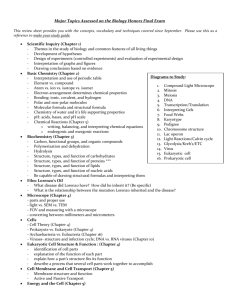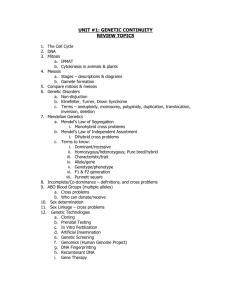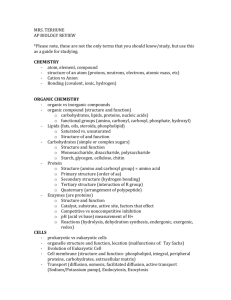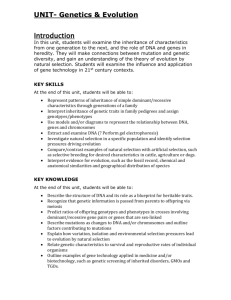File
advertisement
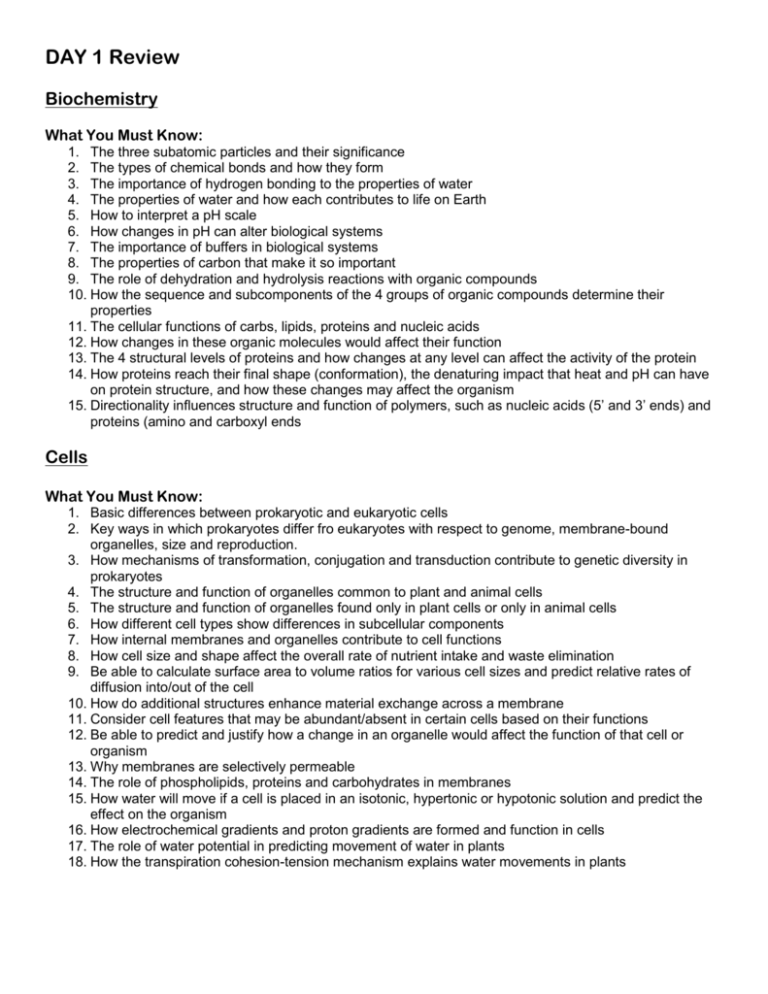
DAY 1 Review Biochemistry What You Must Know: 1. The three subatomic particles and their significance 2. The types of chemical bonds and how they form 3. The importance of hydrogen bonding to the properties of water 4. The properties of water and how each contributes to life on Earth 5. How to interpret a pH scale 6. How changes in pH can alter biological systems 7. The importance of buffers in biological systems 8. The properties of carbon that make it so important 9. The role of dehydration and hydrolysis reactions with organic compounds 10. How the sequence and subcomponents of the 4 groups of organic compounds determine their properties 11. The cellular functions of carbs, lipids, proteins and nucleic acids 12. How changes in these organic molecules would affect their function 13. The 4 structural levels of proteins and how changes at any level can affect the activity of the protein 14. How proteins reach their final shape (conformation), the denaturing impact that heat and pH can have on protein structure, and how these changes may affect the organism 15. Directionality influences structure and function of polymers, such as nucleic acids (5’ and 3’ ends) and proteins (amino and carboxyl ends Cells What You Must Know: 1. Basic differences between prokaryotic and eukaryotic cells 2. Key ways in which prokaryotes differ fro eukaryotes with respect to genome, membrane-bound organelles, size and reproduction. 3. How mechanisms of transformation, conjugation and transduction contribute to genetic diversity in prokaryotes 4. The structure and function of organelles common to plant and animal cells 5. The structure and function of organelles found only in plant cells or only in animal cells 6. How different cell types show differences in subcellular components 7. How internal membranes and organelles contribute to cell functions 8. How cell size and shape affect the overall rate of nutrient intake and waste elimination 9. Be able to calculate surface area to volume ratios for various cell sizes and predict relative rates of diffusion into/out of the cell 10. How do additional structures enhance material exchange across a membrane 11. Consider cell features that may be abundant/absent in certain cells based on their functions 12. Be able to predict and justify how a change in an organelle would affect the function of that cell or organism 13. Why membranes are selectively permeable 14. The role of phospholipids, proteins and carbohydrates in membranes 15. How water will move if a cell is placed in an isotonic, hypertonic or hypotonic solution and predict the effect on the organism 16. How electrochemical gradients and proton gradients are formed and function in cells 17. The role of water potential in predicting movement of water in plants 18. How the transpiration cohesion-tension mechanism explains water movements in plants DAY 2 Review Cell Communication What You Must Know: 1. The three stages of cell communication: reception, transduction and response 2. How a receptor protein recognizes signal molecules and starts transduction 3. How a cell signal is amplified by a phosphorylation cascade 4. An example of a second messenger and its role in a signal transduction pathway 5. How a cell response in the nucleus turns on genes, whereas in the cytoplasm it activates enzymes 6. What apoptosis means and why it is important to normal functioning of multicellular organisms 7. Be able to describe a model that expresses the key elements of a signal transduction pathway leading to a cellular response: G-protein receptors, tyrosine kinase receptors and ligand gated ion channels 8. Describe examples of cell communication from the nervous and endocrine systems 9. Mechanisms by which plant cells communicate with other distant cells Cell Cycle What You Must Know: 1. The structure of a duplicated chromosome 2. The events that occur in the cell cycle (G1, S and G2) 3. The role of cyclins and cyclin-dependent kinases in the regulation of the cell cycle 4. Ways in which the normal cell cycle is disrupted to cause cancer, or halted in certain specialized cells 5. The features of mitosis that result in the production of genetically identical daughter cells including replication, alignment of chromosomes (metaphase), and separation of chromosomes (anaphase) 6. Describe the key characteristics of normal cell division: density-dependent inhibition and anchorage dependency 7. Compare the process of meiosis with mitosis 8. Describe the change in chromosomal number through the cell, the purpose of each process and starting material and product for each Day 3 Review Metabolism and Enzymes What You Must Know: 1. Examples of endergonic and exergonic reactions 2. The key role of ATP in energy coupling 3. That enzymes work by lowering the energy of activation 4. The catalytic cycle of an enzyme that results in the production of a final product 5. Factors that change enzyme shape and how they influence enzyme activity 6. How the shape of enzymes, their active sites, and interaction with specific molecules affect their function 7. How feedback inhibition is used to maintain appropriate levels of enzymes in a pathway 8. Know why certain factors such as pH and temperature affect enzyme function 9. Describe examples of how homeostasis is maintained through molecular concentrations by triggering feedback mechanisms Cellular Respiration and Fermentation What You Must Know: 1. The summary equation of cellular respiration including the source and fate of the reactants and products 2. The difference between fermentation and cellular respiration 3. The role of glycolysis in oxidizing glucose to two molecules of pyruvate 4. How pyruvate is moved from the cytosol into the mitochondria and introduced into the citric acid cycle 5. How electrons from NADH and FADH2 are passed to a series of electron acceptors to produce ATP by chemiosmosis 6. The roles of the mitochondrial membrane, proton (H+) gradient, and ATP synthase in generating ATP 7. The difference between substrate-level phosphorylation and oxidative phosphorylation Photosynthesis What You Must Know: 1. The summary equation of photosynthesis including the source and fate of the reactants and products 2. How leaf and chloroplast anatomy relate to photosynthesis 3. How photosystems convert solar energy to chemical energy 4. How linear electron flow in the light reactions results in formation ATP, NADPH, and O2 5. How the formation of a proton gradient in the light reactions is used to form ATP from ADP + inorganic phosphate by ATP synthase 6. How the Calvin cycle uses the energy molecules of the light reactions (ATP and NADPH) to produce carbohydrates (G3P) from CO2 7. Predict how changes in the pathways would affect the output of ATP in the light reaction 8. Compare the process of chemiosmosis in the mitochondrion and the chloroplast 9. Explain how the H+ gradient is established in both processes and describe the orientation of the ATP synthase molecules Day 4 Review Mendelian Genetics What You Must Know: 1. The differences between asexual and sexual reproduction 2. Advantages of asexual vs. sexual reproduction 3. The role of meiosis and fertilization in sexually reproducing organisms 4. The importance of homologous chromosomes to meiosis 5. How the chromosome number is reduced from diploid to haploid in meiosis 6. Three events that occur in meiosis but not mitosis 7. The importance of crossing over, independent assortment, and random fertilization to increasing genetic variability 8. Know when a cell goes from diploid to haploid 9. Terms associated with genetics problems: P, F1, F2, dominant, recessive, homozygous, heterozygous, phenotype and genotype 10. How to derive the proper gametes when working a genetics problem 11. The difference between an allele and a gene 12. How to read a pedigree 13. How to use data sets to determine Mendelian patterns of inheritance 14. Know when to use rule of addition and multiplication in genetics 15. How the chromosome theory of inheritance connects the physical movement of chromosomes in meiosis to Mendel’s laws of inheritance 16. The unique pattern of inheritance in sex-linked genes 17. How alteration of chromosome number or structurally altered chromosomes (deletions, duplications, etc.) can cause genetic disorders 18. How genomic imprinting and inheritance of mitochondrial DNA are exception to standard Mendelian inheritance 19. Predict a null hypothesis and calculate a Chi-Square analysis Day 5 Review Molecular Genetics What You Must Know: 1. The structure of DNA 2. The knowledge about DNA gained from the work of Griffith; Avery, MacLeod, and McCarty; Hershey and Chase; Wilkins and Franklin; and Watson and Crick 3. Replication is semiconservative and occurs 5’ to 3’ 4. The roles of DNA polymerase, ligase, helicase and topoisomerase in replication 5. The general differences between bacterial chromosomes and eukaryotic chromosomes 6. How DNA packaging can affect gene expression 7. How RNA and DNA are similar and different, and how this defines their roles 8. The differences between replication, transcription, and translation and the role of DNA and RNA in each process 9. How eukaryotic cells modify RNA after transcription 10. How genetic material is translated into polypeptides 11. How mutations can change the amino acid sequence of a protein and be able to predict how a mutation can result in changes in gene expression 12. Genes can be activated by inducer molecules, or they can be inhibited by the presence of a repressor as they interact with regulatory proteins or sequences 13. A regulatory gene is a sequence of DNA that codes for a regulatory protein such as a repressor protein 14. How the components of an operon function to regulate gene expression in both repressible and inducible operons 15. How positive and negative control function in gene expression 16. The impact of DNA methylation and histone acetylation on gene expression 17. How timing and coordination of specific events are regulation in normal development, including pattern formation and induction 18. The role of microRNA’s in control of cellular functions 19. The role of gene regulation in embryonic development and cancer 20. The components of a virus 21. The differences between lytic and lysogenic cycles 22. How viruses can introduce genetic variation into host organisms 23. Mechanisms that introduce genetic variation into viral populations 24. The terminology of biotechnology 25. How plasmids are used in bacterial transformation to clone genes 26. The key ideas that make PCR possible and applications of this technology 27. How gel electrophoresis can be used to separate DNA fragments or protein molecules 28. Information that can be determined from DNA gel results, such as fragment sizes and RFLP analysis 29. Discuss ethical implications of some applications of biotechnology 30. How prokaryotic genomes compare to eukaryotic genomes 31. Applications of bioinformatics to medicine, evolution and health 32. The activity and role of transposable elements and retrotransposons in generating genetic diversity 33. The role of homeotic genes and homeoboxes in developmental patterns and sequences Day 6 Review Evolution What You Must Know: 1. How Lamark’s view of the mechanism of evolution differed from Darwin’s 2. Several examples of evidence for evolution and how they each support how organisms have changed over time: direct observations, homology, fossils and biogeography 3. The difference between structures that are homologous and those that are analogous, and how this relates to evolution 4. The role of adaptations, variation, time, reproductive success, and heritability in evolution 5. How mutation and sexual reproduction each produce genetic variation 6. The conditions for Hardy-Weinberg equilibrium 7. How to use the Hardy-Weinberg equation to calculate allele frequencies to test whether a population is evolving 8. What effects genetic drift, migration or selection may have on a population and analyze data to justify your predictions 9. The biological concept of species 10. Prezygotic and postzygotic barriers that maintain reproductive isolation in natural populations 11. A description of similar species that are maintained separate by each type of isolating barrier 12. How allopatric and sympatric speciation are similar and different 13. How a change in chromosome number can lead to sympatric speciation 14. Why speciation rates are often rapid in situations when adaptive radiation occurs or during time of ecological stress 15. The connection between a change in gene frequency, a change in the environment, natural selection or genetic drift and speciation 16. How punctuated equilibrium and gradualism describe two different tempos of speciation 17. A scientific hypothesis about the origin of life on Earth 18. The age of the Earth and when prokaryotic and eukaryotic life emerged 19. Characteristics of the early planet and its atmosphere 20. How Miller and Urey tested the Oparin-Haldane hypothesis and what they learned 21. Methods used to date fossils and rocks and how fossil evidence contributes to our understanding of changes in life on Earth 22. Evidence for endosymbiosis 23. How continental drift can explain the current distribution of species (biogeography) 24. How extinction events open habitats that may result in adaptive radiation 25. The taxonomic categories and how they indicate relatedness 26. How to construct a phylogenetic tree that represents processes of biological evolution 27. Using data to construct a cladogram and use cladograms to infer relatedness Day 7 Review Physiology What You Must Know: 1. The importance of homeostasis and examples (especially endocrine examples) 2. How feedback systems control homeostasis 3. One example of positive feedback and one example of negative feedback 4. How are nutrients reduced to molecules that can cross into the circulatory system 5. How is the respiratory surface structure related to function 6. Several elements of an innate immune response 7. The differences between B and T cells relative to their activation and action 8. How antigens are recognized by immune system cells 9. The differences in humoral and cell-mediated immunity 10. Why helper T cells are central to immune responses 11. Relate immune response to cell communication 12. Programmed cell death plays a role in normal development and differentiation (morphogenesis) 13. Cell differentiation results from the expression of genes for tissue-specific proteins and the induction of transcription factors 14. Interactions between external stimuli and regulated gene expression result in specialization of cells, tissues and organs 15. The anatomy of a neuron 16. The role of active transport in establishing the membrane potential of a neuron 17. How long-distance and short-distance signaling is done in neurons 18. The mechanisms of impulse transmission in a neuron 19. The process that leads to release of neurotransmitter, and what happens at the synapse 20. The brain serves as a master neurological center for processing information and directing responses 21. Different regions of the brain have different functions 22. Structures and associated functions for animal brains are products of evolution, and increasing complexity follows evolutionary lines 23. How the vertebrate brain integrates information, which leads to an appropriate response 24. Different sensory receptors respond to various types of input 25. Neurons communicate with muscle fibers to stimulate contraction 26. Interaction of cellular organelles leads to muscle contraction 27. Roots, stems and leaves interact in essential plant life functions 28. How plants respond to attacks by herbivores and pathogens Day 8 Review Animal Behavior What You Must Know: 1. How behaviors are the result of natural selection 2. How innate and learned behaviors increase survival and reproductive fitness 3. How organisms use communication to increase fitness 4. The role of altruism and inclusive fitness in kin selection 5. Timing and coordination of reproduction may be triggered by environmental cues as well as pheromones 6. How phototropism and photoperiodism use changes in the environment to modify plant growth and behavior 7. How temperature and moisture determine seed germination 8. The role of auxins in plants Ecology What You Must Know: 1. The role of abiotic factors in the formation of biomes 2. How biotic and abiotic factors affect the distribution of biomes 3. How changes in these factors may alter ecosystems 4. The difference between a fundamental niche and a realized niche 5. The role of competitive exclusion in interspecific competition 6. The symbiotic relationships of parasitism, mutualism, and commensalism 7. The impact of keystone species on community structure 8. The difference between primary and secondary succession 9. How density, dispersion and demographics can describe a population 10. The differences between exponential and logistic models of population growth 11. How density-dependent and density-independent factors can control population growth 12. How a change in matter or energy will affect the population or community 13. The effect of age distributions and fecundity on human populations as presented in agestructure pyramids 14. How do human and global natural events impact ecosystem distribution 15. How energy flows through an ecosystem by understanding the terms in bold that relate to food chains and food webs 16. The difference between grow primary productivity and net primary productivity 17. The carbon and nitrogen biogeochemical cycles 18. How biogeochemical cycles impact individual organisms and/or populations and ecosystems 19. Predict the effects of a change of matter or energy availability in an ecosystem 20. Be able to use a representation to illustrate the movement of matter or energy through an ecosystem 21. The value of biodiversity and the major human threats to it 22. How human actions are changing the Earth 23. How to predict consequences on both local and global ecosystems of specific human activities

